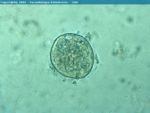Protozoa Life Cycle
Jump to navigation
Jump to search
Protozoa multiply sexually, asexually and can also use a combination of both, as seen in the coccidia class. Replication can be by binary or multiple fission. Different protozoa use different forms of motility, including flagella, cilia, pseudopodia and gliding.
- Most protozoal reproduction is asexual via binary fission, schizogony and sporogony
- Some protozoa also use sexual reproduction called gametogony
- In some species, sexual and asexual reproduction occurs in the same host, whilst in others asexual reproduction occurs in the vertebrate host and sexual reproduction in the arthropod vector
- Homoxenous
- Parasite uses a single host species during its life cycle (direct)
- E.g. Eimeria
- Heteroxenous
- Parasite uses more than one host during its life cycle (indirect)
- E.g. Trypanosomes
- Facultatively heteroxenous
- Parasite may use more than one host during its life cycle but this is not essential
- E.g. Toxoplasma gondii
